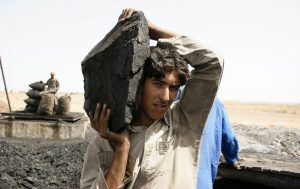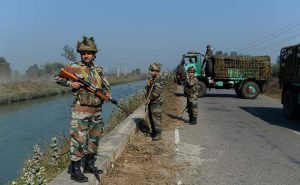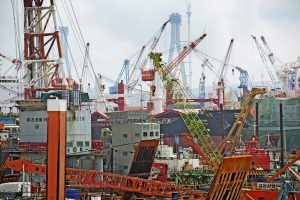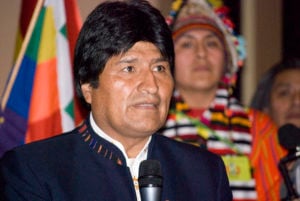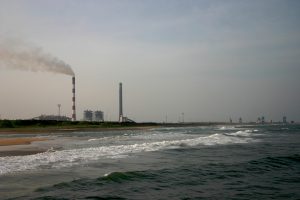Ramesh (not his real name) sits in front of plastic bottles and containers of yellowish liquid at Kothputli, a town between New Delhi and Jaipur. He is one of many dozen young men involved in an illicit trade that occurs along the busy National Highway 8 that connects India’s capital city, New Delhi, to Jaipur, the capital of the western state of Rajasthan and a tourist centre popular for its historical forts. These young men are selling fuel at cut rate prices to those driving motorcycles and trucks, much lower than the prices prevailing at regular retail outlets selling motor spirit or petrol and high speed diesel. They are able to do this because anywhere between a tenth and a third of the fuel he sells has been adulterated with what is known in petroleum industry jargon as superior kerosene oil or simply, kerosene.
Kerosene is supposed to be the “poor man’s fuel” in India. It is a petroleum product which is heavily subsidised by the federal government and sold at half its “market value”. Kerosene is meant to be used by the poor and those living in remote areas. Together with liquefied petroleum gas (LPG) or cooking gas, it is meant to be used for cooking and lighting to reduce the burning of wood, dry leaves, agricultural waste and cow-dung cakes to conserve the environment. While fuel subsidy policies are framed by the federal government in the country, kerosene is distributed through a public distribution system (PDS) of shops run by provincial or state governments.
Kerosene is supposed to be sold at the officially administered price of INR 14.96 (USD 0.22) per litre against its market price of INR 29.91 (USD 0.44) or the price at which oil refining and marketing companies, most of them owned by the government, would recover their costs and expenditures.
Subsidised and stolen
According to statistics included in Page 23 of the annual Economic Survey, a document of the Ministry of Finance released at the end of February each year, a very substantial portion – as much as 41% – of kerosene that is distributed publicly is “lost as leakage and only 46% of the remainder is consumed by poor households”. What is not explicitly stated is that “leakages” include illegal diversion.
The government has over the years tried various methods — including colouring kerosene blue — to curb adulteration but these have not been particularly effective. The incentives to adulterate are huge. Diesel and petrol cost roughly four times as much as PDS kerosene, and without a laboratory test petrol or diesel can have as much as 10% to 20% kerosene content without being detected.
The profits from selling kerosene in the black market are enormous — one government estimate states that the covert business may be worth as much as INR 100 billion per year (USD 1.49 billion).
Diverting kerosene to the black market is an organised racket and at least two honest officers have recently been killed by the fuel mafia. Yeshwant Sonawane, an additional district collector of Malegaon, a city in the western state of Maharashtra, was burnt alive in January 2011 when he attempted to stop rampant adulteration of petrol with kerosene. A similar fate had earlier met Shanmugam Manjunath, a young manager who worked for the public sector Indian Oil Corporation (IOC) who was murdered in November 2005 for shutting down a corrupt petrol station in Lakhimpur Kheri, Uttar Pradesh.
An estimated 300 million people in India, roughly one-fourth of the population of the country and equal to the total population of the United States of America, do not have access to energy. This makes issues surrounding subsidies and spending on energy among the most pressing and contentious issues in recent economic and political debates in India. In 2015, the Comptroller and Auditor General of India (CAG), the apex government auditor, revealed the assessment that the government had understated its subsidy bill for 2015 by INR 44,941 crore (USD 6.7 billion).
In the same year, however, the federal government claimed that reforms were bringing subsidies under control and estimated the total subsidy bill for 2015-16 to be around INR 40,000 crore (USD 5.9 billion). The government is attempting to ensure what it calls direct benefits transfer (DBT). This entails moving the subsidy on a cylinder of liquefied petroleum gas (LPG), used mainly for cooking, directly into the bank account of the intended beneficiary by linking it to a unique “Aadhaar” card, a national identity card system for all Indian citizens. The Aadhaar card has a 12-digit identity number for each individual together with biometric and demographic data.
The reforms have so far been only partially successful because roughly a fourth of the population does not have bank accounts, plus many accounts are dormant with a zero balance.
A research study on fossil fuels by the International Institute for Sustainable Development reveals that during 2013 and 2014, on an average, India provided Rs 697.31 crore (USD 103 million) per year in national subsidies to gas, oil and coal producers over and above the subsidies given to consumers.
Expenditure on subsidies have a critical impact on the government’s budgeting process, particularly in adhering to the provisions of the Fiscal Responsibility and Budget Management (FRBM) Act of 2003, a law meant to institutionalise financial discipline and reduce the federal government’s budget deficit.
[iframe src=”https://magic.piktochart.com/embed/11320365-untitled-infographic” width=”100%” height=”350px”]
Subsidies unsustainable
Many economists have long argued that the amount and nature of subsidies being provided in India are becoming unsustainable. This is because costs accrue not just in the shape of official pre- and post-tax subsidies to producers and consumers but also include the costs of climate change and pollution and the opportunity cost of tax revenues. Cross subsidisation also leaves significant footprints which are not accounted for in official calculations.
Yet, in India as in other countries, removal of subsidies that are meant for the underprivileged – even if these do not reach them – is politically difficult because it makes the incumbent regime unpopular.
There are currently three ministries in the government of India that deal with energy: coal, power and new and renewable energy. They report to the Minister of State with Independent Charge for Power, Coal, New and Renewable Energy, Piyush Goyal. The coal ministry determines coal policies and strategies with public sector coal companies, while the power and new and renewable energy ministries guide major research and development initiatives.
Oil refining and marketing is dominated by a clutch of oil corporations led by the Indian Oil Corporation (IOC), one of the biggest companies of its kind. The IOC sells a little under half of all petroleum products sold in India and accounts for almost a third of the country’s total crude oil refining capacity.
The subsidy scenario for petroleum products is complicated because both the federal government and 29 state governments are involved. While policies and decisions on subsidies are made in Delhi, the actual distribution is carried out through the civil supplies departments of state governments. This means that when issues relating to leakages and adulteration arise, there is frequently a tussle over the apportioning of blame and responsibilities.
For India, the issue of energy subsidies is particularly significant because it is the world’s third largest energy consumer and the second most populated nation on the planet and, given its urbanised, manufacturing-driven development agenda, its energy requirements are expected to grow rapidly.
According to projections made by the International Energy Agency, India’s energy consumption will be more than that of the countries that are part of the Organisation of Economic Cooperation and Development (OECD) in Europe and will approach that of the United States by 2040. However, while such numbers may sound impressive, in per capita terms, India consumes far less energy than the United States or China.
[iframe src=”https://magic.piktochart.com/embed/11322363-indias-energy-consumption” width=”100%” height=”350px”]
India’s total energy consumption in 2014 was 872 Mtoe (million tonnes of oil equivalent), whereas the United States and China’s consumption for the same year were 2,224 Mtoe and 3,034 Mtoe respectively.
Globally, energy subsidies are projected at USD 5.3 trillion in 2015 (6.5% of global GDP), according to a recent study by the International Monetary Fund (IMF). A large portion of this is because countries are setting energy taxes below levels that genuinely reflect the environmental damage associated with energy consumption. The IMF’s country profile places India’s post-tax subsidies on petroleum at USD 72.19 billion, on coal at USD 195.82 billion and on natural gas at USD 9.29 billion.
Subsidies, despite their objective of bringing about “inclusion”, can have a perverse effect (as in case of kerosene diversion) and have made the energy space in India a hotbed for a variety of malpractices.
![<p>A child awaits her turn outside a shop selling kerosene at a subsidised price in Alwar district, Rajasthan [image by Sajjad Hussain, AFP]</p>](https://dialogue.earth/content/uploads/2016/02/Fossil_Fuel_Subsidies_Story_1_Pic.jpg)
